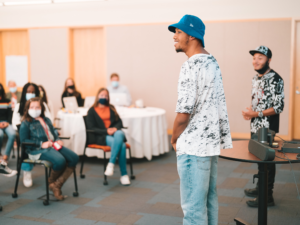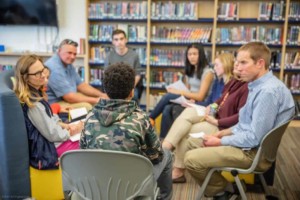10 Challenges Deaf Students Face in the Classroom

Imagine trying to learn a lesson in a classroom trapped inside of a clear sound-proof box. The only way you can gather information is visually and you will be tested on what you’ve learned – or were supposed to have learned – at the end of the day. Seems a bit unfair, doesn’t it?
The only way you can gather information is visually and you will be tested on what you’ve learned – or were supposed to have learned – at the end of the day. Seems a bit unfair, doesn’t it?
This could be anything from the basic ABC’s to complex mathematical equations – deaf and hard-of-hearing students face many challenges in their day-to-day lives. So much so that their challenges in the classroom are all too often over-looked.
With that being the case, here are 10 challenges that deaf and hard-of-hearing students face in the classroom, along with guidelines for teachers on how to mitigate them:
- Classroom Acoustics: Acoustics are often a problem in the classroom, but luckily there are several ways to solve this challenge. Deaf or hard-of-hearing students need full visual access, so the best seating arrangement for full participation, engagement and access by these students is to arrange desks in a “U” shape. This will allow the students to see who is speaking, and participate fully in the conversation.
Also, we recommend not placing a deaf or hard-of-hearing student near the A/C unit in a portable building or near a window. Hearing aids can pick up and amplify all outside sounds – making it impossible to understand what is happening inside of the classroom if you place a student by a window. Be mindful that if there is carpet in the room–it helps with the distinction of sounds versus hardwood floors, allowing sounds to bounce around and become overwhelming.
- Lighting: Fluorescent lights emit a special sound that interferes with hearing aids and cochlear implants, making it even more difficult when trying to distinguish what peers or the teacher are saying. Consider the placement of the window in relation to the teacher, the interpreter and the deaf or hard-of-hearing student. Windows and light should not be behind the interpreter or teacher because this makes it difficult, if not impossible, to see the signs produced by the interpreter or the teacher’s lesson.
- Language Deficiencies: Keep in mind that some deaf students’ first (or second!) language may not be English. Be sure to provide an appropriate interpretation service that will effectively communicate the lesson in their primary language.
- Experiential Shortages: Research shows that deaf students often lag behind their hearing peers when it comes to number concepts, language and problem solving skills. Hearing students constantly absorb new information and knowledge through the daily noises, conversations and language that is spoken around them. Deaf and hard-of-hearing students do not have that luxury. Teachers can bridge this gap by being flexible in the way that they respond to the educational concerns of their deaf students.
- Lip-Reading/Residual Hearing: Teachers often hypothesize that their deaf students are capable of lip-reading – which can be true – but it is essential to keep in mind that only 30-40% of spoken English is distinguishable on the lips. Students who rely on lip-reading often perform better when it is a subject that is familiar. When lecturing students, teachers should consistently face their deaf students, never talk when handing out papers, pause before heading into a new subject and give the deaf student applicable time to process the preceding subject’s information in case he/she has any questions.
- Inadequate Knowledge and Awareness: Every child learns differently. Even if teachers are given instruction on how to best assist one of their deaf students, it could be completely different for the next, resulting in an academic gap.
To minimize this educational gap, teachers could present the directions of tasks in an assortment of ways to be positive that the deaf student will comprehend and complete tasks properly. It is important to not assume that because a student can hear sound and voices, that he or she can distinguish speech and process acoustical language.
- Social Concerns: Children who are deaf often tend to feel uncomfortable in the classroom when drawing attention to their hearing problem. They want to be like their friends with ‘normal’ hearing, so this drives them to mainly keep to themselves and prefer to not take part in classroom activities.
This lack of engagement and attention often wears on the child, making them tired and can cause headaches. When arranging seating charts, keep in mind that it is best to incorporate deaf students into smaller groups. This will help the child relax and focus on their school work rather than unwanted, distracting social interactions.
- Collaboration: Due to busy schedules during the school year, it is often difficult to hold regular, collaborative meetings with the individuals that are critical components to a deaf student’s academic progress. We recommend that teachers remain in constant, close communication with the student and his or her parents, as well as make sure the interpreter is available to assist with complete understanding. This will ensure that everyone is on the same page and is available for ongoing conversations about proper educational techniques and adequate learning environments for the deaf or hard-of-hearing student.
- Curriculum and Instruction: Some teachers require all students to take lecture notes during class. A suggestion to assist the deaf student with this requirement would be to provide them with a written or digital copy of the lecture information beforehand. If it is preferred that the student engages more actively in class, teachers can provide a printed copy listing key points, so that the majority of the student’s attention remains on the lesson. We also encourage teachers to use interactive whiteboards if available.
- Lack of Resources: Often schools are not capable of supplying their deaf or hard-of-hearing students with the proper technology that could significantly increase the learning development process. This could be any form of assistive technology – interactive whiteboards, VRI, chat rooms, strobe lights, digital pen technology, closed captioning on all movies and videos, infra-red systems – hearing aid compatible, computer assisted note taking, ASL videos for testing materials, alert systems such as vibrating systems, and alarms and interpreters in the classroom.
These are only 10 of the many challenges that deaf and hard-of-hearing students face in the classroom, and we hope it helps open conversations in your school and district about taking a few additional steps to assist deaf students in the classroom. By acknowledging the challenges deaf students are facing and implementing strategies to alleviate those learning barriers, teachers create a learning environment that will benefit all students every day.
For more, see:
Stay in-the-know with all things EdTech and innovations in learning by signing up to receive the weekly Smart Update.





Ronald
A very informative article. Kudos!! for the good work.
Ronald Gough
The articles said "Be sure to provide an appropriate interpretation service ...". Wonder why didn't mention American Sign Language?
Replies
Soud Omar
there are many sign language why would he mention only American Sign language that article is for all not just Americans
Tiff Dodge
NOt every student who signs is actually given a American Sign Language. There are various forms of signed English (not unique and/or full languages like ASL, but rather a variant of English). Many parents have been advised to not allow their child to use ASL. Even those who do choose to sign often use signed English because ignorant professionals say it will help them with their spoken and written English (which ASL actually supports better).
Megan
Many of these are incorrect and offensive; these give the wrong idea to many parts of Deaf education. When it comes to the social aspect of education, how do you know that all Deaf children are embarrassed of their Deafness? How do you know they want to be like their hearing peers? That is extremely generalizable.
Also, when you mention "Language Deficiencies,"... This is an entirely wrong term to be used. Language DIFFERENCES would be a better term. The definition of deficiency is "lack or shortage" or "failing or shortcoming", giving the idea that the use of ASL (or any other language) is a lack of language which is simply not true. Using an interpreter does not mean that their language is considered a shortcoming.
You must do more research on Deaf Culture and in the field of Deaf Education. Your terminology alone gives the wrong idea about Deafness. Not all, but some of these "10 Challenges" would be completely opposed by someone who has a first hand experience with Deafness in a school.
Replies
Tiff Dodge
These statements are not incorrect. There is an abundance of research that has been done that validates every single one of these for a large population of Deaf/Hh students, whether they identify as Deaf or just as having a hearing loss. Academically, the majority of Deaf students do have language deficiencies. They are lacking language skills and this has been measured numerous times by those who support the use of ASL and those who oppose it--especially written language skills. Even students who do sign often show deficiencies in ASL since only approx 15% of Deaf children are given ASL from birth, and only 10% are given it from native users who are themselves proficient in ASL. The article specifically says make sure you use appropriate interpretation services. It does not say providing such services is bad. Research also does show that a large amount of Deaf students are uncomfortable in mainstream schools socially and emotionally. At no point does this article state ALL or even MOST Deaf/Hh students. These statements are indeed accurate and backed by evidence. Using different words like "differences" not only hides the facts, but alters them.
Lavenda Nasolo Malaba
This was a very helpful information,good job
NAIMA KIBIBI BAKARI
lovely,,thanx very much,this helped me in my research.
Kahutipe
Your are quite right. These challenge are common in classroom as institutions of learning tend to fail to provide appropriate learning environments to deaf students. Primarily, this is because many schools and colleges lack understanding of unique needs of deaf populations as hence they tend to treat them in the same way as they treat hearing students.